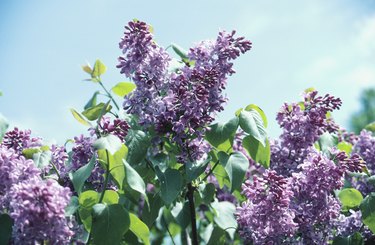
Lilacs, among the most beautiful and fragrant of bushes, produce blossoms that usually range from soft pink to misty lavender to eye-catching purple; white and yellow varieties are also available. Although their blooming season is brief--they only flower for a few weeks in the spring--the rest of the season they make attractive, leafy shade bushes and privacy screens. Unfortunately, lilac bushes can develop powdery mildew, an unsightly fungal disease. Armed with the proper gardening techniques and fungicide, you can banish powdery mildew and protect your lilacs.
Powdery Mildew
Video of the Day
Powdery mildew, caused by the microsphaera alni fungus, usually starts on older lilac leaves around July. It spreads up the bush from mid-August through the fall, and dies off in October with the first frosts. It is spread when spores that have overwintered on fallen leaves are released in the spring during wet weather, and then windblown or splashed onto foliage. The spores penetrate the epidermal cells of the lilac leaves, which develop patches that look like white or grayish felt; eventually, affected leaves turn from yellow to black and fall off. Although powdery mildew usually won't kill your lilac bushes, it can ruin their appearance and can reduce or stop next season's blooming. Conditions favorable to powdery mildew development include warm, humid weather, too much shade, over-fertilization, crowding, and over-watering.
Video of the Day
Powdery Mildew Treatment
The best way to treat powdery mildew is to spray it with a commercial fungicide containing chlorothalonil, copper, sulfur, or triadimefon as its active ingredient. According to information on the University of North Dakota Hortiscope website, fungicides made with neem tree extract are also effective for controlling powdery mildew and other fungal diseases, as well as spider mites. You can treat powdery mildew naturally by spraying lilac bushes with a mixture of baking soda, dishwashing liquid, and water, but this may not be totally effective if the mildew is already well established. To spray commercial fungicide preventively, hold your fire until June 1-- about the time your lilacs should start blooming.
Powdery Mildew Prevention
Practice good gardening techniques to prevent powdery mildew from infecting and disfiguring your lilacs. Clean up dead leaves around bushes, and provide them with full sun and good air circulation. To avoid creating conditions favorable to powdery mildew, don't overcrowd your lilacs, and water them properly--don't wet foliage more than necessary, and avoid splashback from the ground to the lower leaves. If you intend to plant new lilacs, choose from mildew-resistant varieties, which include the s diversifolia and s. emodi cultivars.